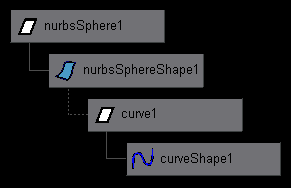A node that contains an object’s transformation attributes—values for its translation, rotation, scale, and so on. It also holds information on parent-child relationships it has with other nodes. InnerSolarSystem, Sun, Moon, and all other boxes shown in the example are transform nodes.

Holds an object’s geometry attributes or attributes other than the object’s transform node attributes. A shape node is the child of a transform node. A transform node has only one shape node.
There are several nodes, such as unitConversion, which are hidden to reduce clutter in the editors. They are not normally useful to see or edit; however, if you need to you can show these nodes. (You can also hide nodes that are normally shown if you want to further reduce clutter.)
Any object hidden using Display > Hide. Maya hides the default cameras (top, front, side, and persp) by default.
A pair of nodes below a shape node. When you create a curve-on-surface, Maya creates an underworld transform node and shape node for the curve-on-surface below the surface’s shape node. The CV positions of underworld nodes have UV coordinates on the surface rather than coordinates in world or local space.
Materials and textures each have nodes containing attributes that control their look. Texture placement nodes have attributes that control how a texture is fitted onto a surface.
Lights are of course nodes too, with attributes controlling their properties.
You can organize nodes within the dependency graph into logical node groupings using Asset Nodes. An asset node is a special type of node that lets you:
Asset nodes do not change the hierarchical relationships between nodes. Asset nodes can be created, and modified using the Hypergraph’s Edit menu or by using the icons on the Hypergraph Toolbar.
You add and modify attributes and make attribute connections to asset nodes (and the nodes placed within them) just like you would other nodes in Maya. For more information see Connect input and output attributes.
Maya has a few utility nodes that provide extra functions you can use in a shader network. For example, multiply/divide nodes let you alter inputs and outputs between other nodes.
Script nodes are a way of storing a MEL script in a Maya scene file:
You can set a script node to execute its “payload” in response to various events:
If you select Create > NURBS Primitives > Sphere to create a sphere, Maya creates a transform node and a shape node.
The sphere’s shape node holds the mathematical description of the sphere’s shape. The sphere’s transform node holds the sphere’s position, scaling, rotation, and so on. The shape node is the child of the transform node.
If you select Options > Display > Shape Nodes in the Hypergraph, the scene hierarchy shows these nodes for the sphere:

Maya gives the nodes the default names shown in the preceding figure. The transform node is nurbsSphere1, the shape node is nurbsSphereShape1. If you rename the transform node, for example, to Bubble, Maya renames the shape node to BubbleShape.
If you rename the shape node, Maya does not rename the transform node. Maya doesn’t transmit a child’s attribute changes up to its parent.
If you select Create > NURBS Primitives > Sphere to create a sphere, Maya creates a transform node and a sphere node. If you then select Modify > Make Live, then use the Create > CV Curve Tool to draw a curve on the surface of the sphere and turn on the display of shape nodes and underworld nodes, the scene hierarchy appears as follows:

Maya gives the nodes the default names shown. The transform node is nurbsSphere1, the shape node is nurbsSphereShape1. The curve1 and curveShape1 nodes are underworld nodes for the curve created on the sphere’s surface.
When a curve-on-surface is hard to select in the workspace because of crowding or complex geometry, you can select it easily in the scene hierarchy with underworld nodes displayed.